Remember that sense of exhilaration when you’d get in the car to go on a road trip? The open road beckoned as you settled into your seat, strapped your seatbelt on and let familiar scenes give way to new, exciting vistas. Then, in March 2020 it all went away when we all acquired a new Covid-19 vocabulary but no one suspected it would go on so long, month after month of agonizingly variable CDC travel restrictions that left so many of us isolated and confused. I needed a pandemic road trip strategy.

It’s been a year of many changes and being tied so closely to home has been an adjustment for many of us. When will travel return to normal? No one knows, but with vaccines comes hope. Our travels were severely curtailed, with restrictions varying based on a confusing set of ever-changing formulas. Every single person has had to make their own choices and our choice was to follow the science, data and advice from experts. Masks went on, friends were held at arm’s length and Zoom became a mainstay of social activity.
Things are changing slowly. The restrictions have been eased, we’ve been fully vaccinated with two doses of the Pfizer vaccine and we’re finally ready to venture out of our cocoon. We’ve started taking some short trips and even a week-long trip. After experimenting with different strategies, I’ll outline what’s working for us. Some will find our strategies excessive and others may think we’re being too casual. Everyone has to choose their path forward.

What hasn’t changed for us yet is that we still wear masks when interacting with others and while skiing or hiking, we don’t do indoor dining or entertaining and we have limited contact with non-vaccinated people. We will likely start socializing with small groups of vaccinated people soon. I am more concerned with respiratory transmission than contact surfaces so staying in hotels or condos doesn’t worry me. I look forward to a return to normal but until we know more about Covid-19 variants, we’re not taking any chances.
We’ve stayed in budget motels, luxury hotels and condominiums during the pandemic. In some places, mini-refrigerators and coffee-makers were removed from hotel rooms due to Covid-19 restrictions. This meant that every single bit of food or liquid other than water had to be purchased unless we brought some from home in a cooler. Motel breakfasts that might have once included hot food were sometimes replaced with a brown bag option with a granola bar, apple or orange, string cheese and yogurt while other places still provided a microwaveable breakfast sandwich heated by a staff member. High end hotels either provided a restaurant meal (takeout only during the most severe restrictions) or an overpriced (bad) bagel sandwich from the snack bar.
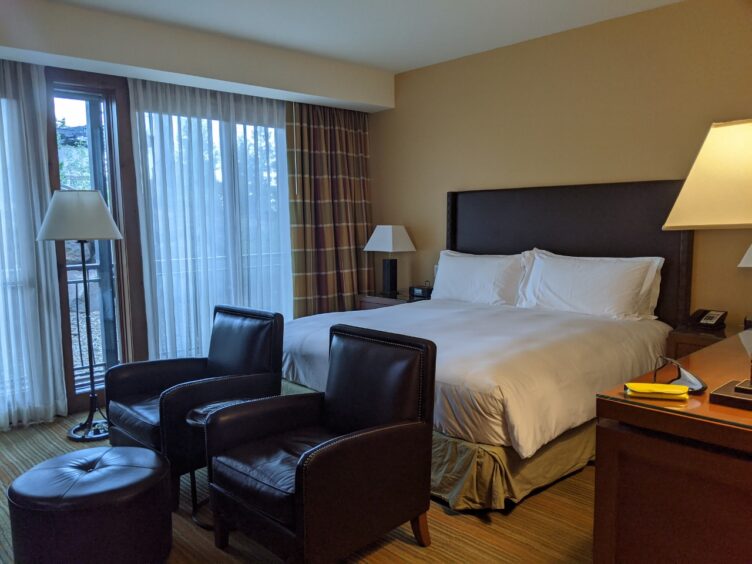
Bringing meals back to the room was problematic for places that didn’t have appropriate furniture or garbage cans. The lovely overstuffed chairs arranged in front of the fireplace with the tiny cocktail table between them were hardly conducive to having cereal and coffee for breakfast or Pad Thai and a glass of wine for dinner. In one place, the chairs were very low in comparison to the table, with awkward elbows flying out to the sides. The small garbage cans quickly overflowed with the bulky containers and food odors lingered in the room. In places with a desk, one person used the desk as a table while the other managed with the small table.

What has worked best for us is staying in condominiums with a full kitchen. Even so, we’ve been caught by surprise when we didn’t examine photos closely enough. Ideally, the full kitchen means that there is a standard four-burner stove, microwave, full-sized refrigerator and dishwasher. It’s amazing how photos can distort reality and make a miniature kitchen look normal despite petite appliances. The kitchen in this hallway worked well.
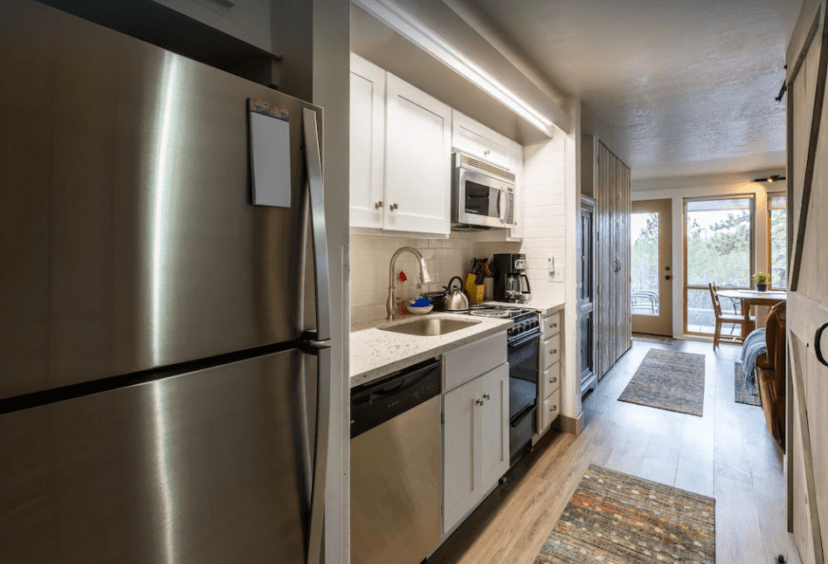
Another ideal that I now look for is a dining table that seats at least two and preferably four people with straight backed chairs after experiencing one small counter with tall stools as the only seating besides a sofa and over-stuffed chair. Even with just two of us, a larger table is more comfortable for sharing meals and to use as a desk.

One bedroom is fine for us as a couple but some places are very small. It is a nice luxury when we find a reasonably priced two-bedroom condo, especially during ski season when we have a lot of bulky winter clothing and gear. We often use the second bedroom as a staging area, with one twin bed for Steve’s gear and one for mine.
If you are like us, Zoom doesn’t stop, whether for work, volunteer, class or social visits. If Zoom is a part of your life, go through photos of your proposed lodging and picture where you will sit for 1-3 hours on Zoom. One place had no straight-backed chairs and no dining table. I dragged a flimsy card table over to an easy chair and made the best of it for my three-hour class but my back had words for me by the end.
Also, make sure the place has adequate WiFi. I use a Lume Cube light that clips onto my laptop to illuminate my face in dark corners where a desk might be located.

We often bring a minimum of a cooler and one grocery bag or dry or packaged foods. In the cooler might be yogurt, milk (in a thermos), juice, eggs (fresh and hard boiled) a couple of containers of frozen chili, stew or pasta sauce, fruit, salad, salad dressing, cheese and butter. The bag is filled with our favorite snacks, nuts, chocolate bar, canned vegetables, canned soup, tuna packets, canned herring or mackerel, olive oil and a variety of dehydrated foods from our pantry (see below). If we’re planning to make sandwiches, we’ll bring bread and jars or packets of condiments.
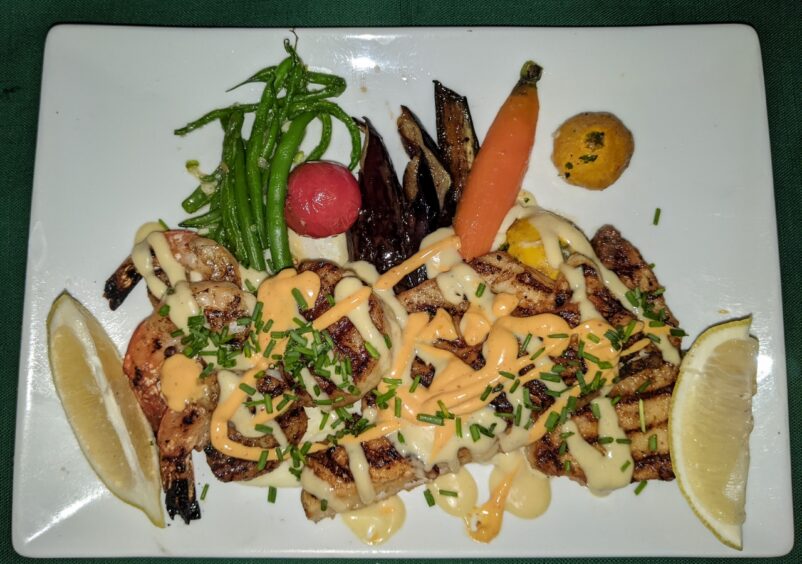
If we are away more than two nights, we’ll usually bring a couple of homemade frozen meals and get takeout meals from a restaurant or grocery store for the rest.
I usually pack a lunch for the road trip. This gives us flexibility to stop anywhere, preferably with a nice view.
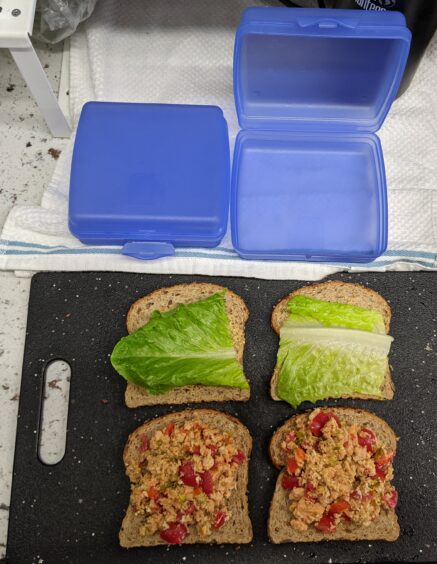
We’re big backpackers and I prepare our backcountry meals from dried ingredients, either freeze-dried foods that I purchase or home-dehydrated foods. As I was packing for a ski trip, I realized that some of those staples could supplement our meals. The dry foods take up less space, don’t have to go in the cooler and can be used over several trips. They provide some bright flavors or added nutrition and can supplement canned food or frozen meals. See below for some examples.
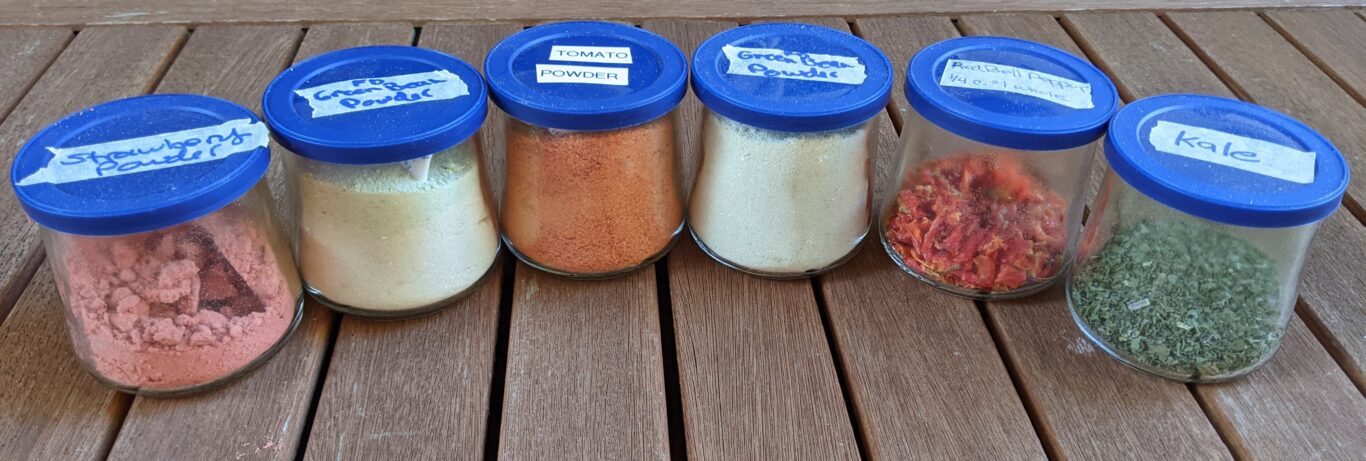
We aren’t as concerned as others about hard surfaces but for those who are, there’s nothing wrong with bringing your disinfectant wipes to wipe countertops, handles and other surfaces. Another good strategy if you’re not sure how long the room has been empty is to immediately open all windows and give the room a good airing out.
I keep a few pairs of latex gloves in the car and alcohol wipes. I either use the gloves when getting fuel for the car or wipe my hands with an alcohol wipe when I’m back in the car or both.
We’ve debated different strategies for when and how we’ll travel by air domestically and internationally but haven’t taken that leap yet. So far, our plan is to wear masks on the plane (maybe forever? I’d love to not get a cold or flu every time I travel), fly business class for long flights when possible, choose destinations that have lower rates of Covid and higher vaccination rates and perhaps start taking into consideration the quality of health care in the destination we’re considering.
Our bubble will expand over time and hopefully, these precautions will be less prominent at some point. In the meantime, every person has to make their own decisions and hopefully understanding our pandemic road trip strategy will help others find their own path.
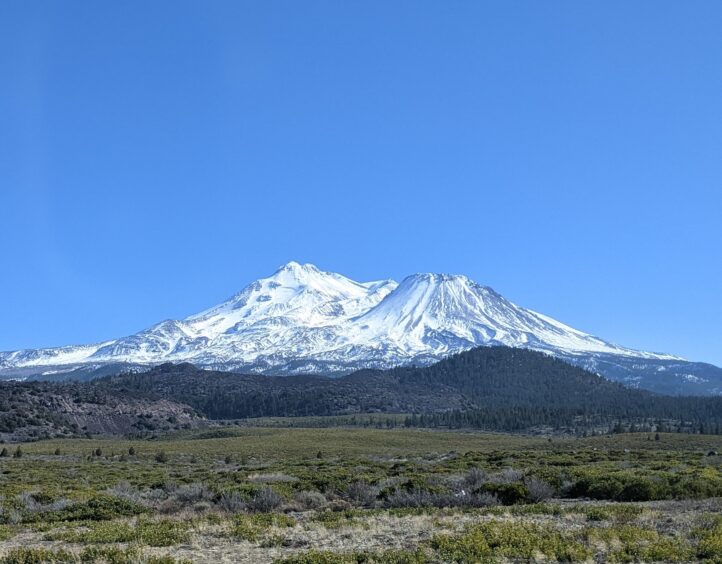
Follow us on one of our pandemic road trips to Mt Bachelor.
Judy Nespeca says:
Hi Inga ,
I’ve been enjoying your blog today – I felt tHe need for adventure so I’m working my way through your site.
You are a fabulous writer and photographer and I love all your fabulous tips.
2021 was certainly an interesting year and 2022 leaves us to wonder what next?
I’m enjoying being back in my townhome and now that the decorations are put away I am relaxing on a day off from Bristlecone. My 3 days a week from 11:30 -4:30 is a perfect outlet for me.
Im redefining my goals for 2022 and right now I’m planning on spending a few weeks every other month with my dad in his place. This Christmas I was able to stay with him in his home for a week which was helpful to see how he is getting along at 98. He is anemic and I took him for his first Aranesp shot, I hope it works for him. He is in stage one age related kidney failure . The retirement community he and mom chose 12 years ago has proved to be a godsend. It was a special holiday for us with my brother and his wife and their daughter Sabrina at marks home.
I flew a few times in 2021 due to moms passing and take every precaution – it’s wonderful to have the test kits so I can take every precaution for myself, dad and family .
I flew down to pick up my dad last august and brought him to basalt for a month – he did amazing at this altitude tired but always maintained an o2 sat of 90- we enjoyed the hot springs having picnics by the rivers and taking drives to small towns close enough to return to home in the same day.
I surprised him and my sister Nancy in Ohio flew to seattle to bring Mary Kay to visit and he had “all,his girls “ for a week .
We finally have some big Snow and more coming the next few days. I’m getting over my holiday travel exhaustion – cancelled flights etc and looking forward to skiing this Sunday. Last winter the slopes were my go to place no lift lines at all and no people – not good for the resort business but great for the locals!
How is your father ? Is it so hard watching my dad try to remain independent- our biggest hurdle is discussing with him giving up his driving and using Casa transportation services. He has 20/20 vision with cataract surgery – extremely HOH and the natural slowing of reflexes
May 2022 bring more adventures for us all – safely
Stay healthy give my love to Steve
Hugs
Judy